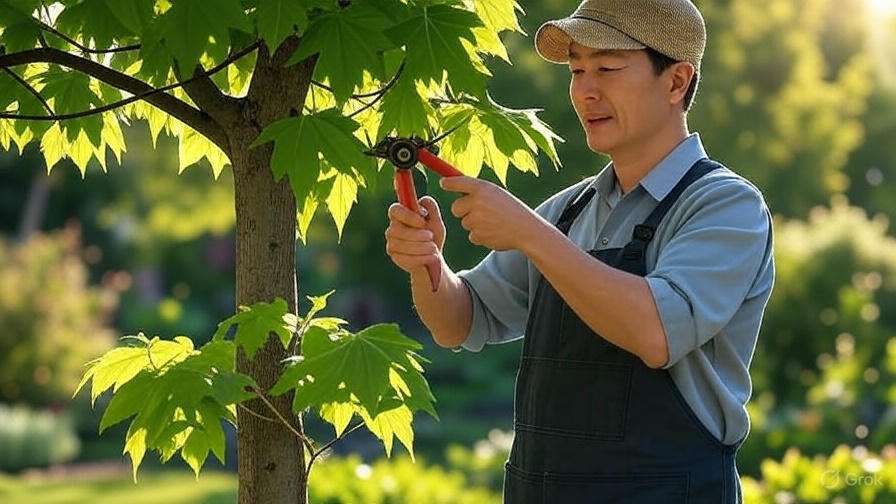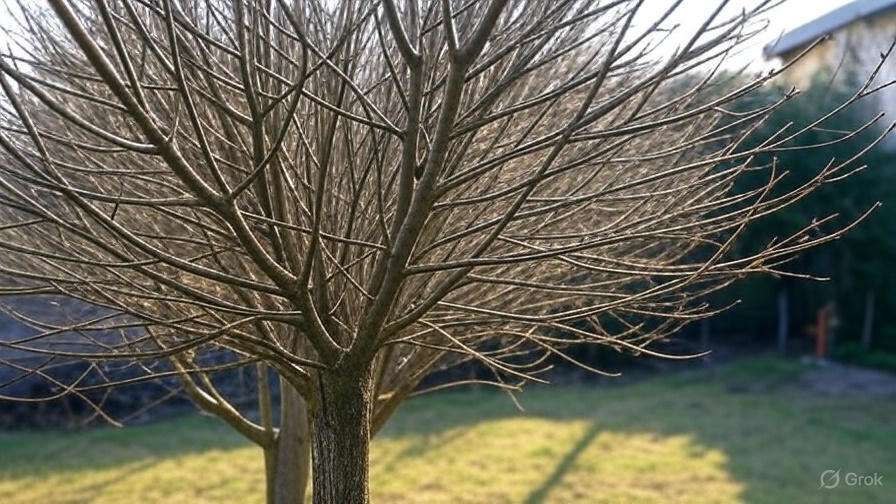
When to Prune Maple Trees: The Best Time for Healthy Growth and Shape
Pruning your maple tree at the right time is key to ensuring it grows healthy and maintains its beautiful shape. 
In this guide, we’ll walk you through the ideal timing for pruning maple trees and explain why it matters. Whether you’re a seasoned gardener or just starting out, these tips will help you keep your maple tree thriving and looking its best. Keep reading to learn how to master the art of pruning and give your tree the care it deserves!
Table of Contents
ToggleWhy Pruning is Essential for Maple Trees 
Pruning is crucial for keeping your maple trees healthy, vibrant, and well-shaped. Not only does it improve their appearance, but it also helps promote stronger growth and better overall health. Here’s why pruning should be part of your tree care routine:
1. Encourages Healthy Growth 
Pruning helps eliminate dead or diseased branches, allowing the tree to focus its energy on new, healthy growth. By cutting away old, weak wood, you make room for fresh shoots that are better able to thrive. This results in a more robust and flourishing maple tree.
2. Improves Shape and Structure 
A well-pruned maple tree will have a balanced shape, which improves its aesthetic appeal. Removing excessive or poorly-placed branches also helps maintain a strong, stable structure. This is especially important for younger trees to ensure they grow properly and are less prone to damage in storms.

3. Prevents Overcrowding 
When branches grow too close together, they can block sunlight and air circulation. This can create a damp environment that encourages mold, mildew, and pests. Pruning reduces overcrowding, ensuring each branch has enough space to grow and receive the light it needs.
4. Boosts Safety 
Sometimes, branches can become too large, heavy, or damaged, posing a safety hazard. By pruning these branches regularly, you reduce the risk of falling limbs that can cause injury or property damage, particularly during storms or high winds.
5. Helps with Disease Control 
Removing diseased branches early prevents the spread of harmful pathogens throughout the tree. By trimming away infected areas, you help protect the health of your maple and neighboring trees. Pruning also allows for better airflow, reducing conditions favorable for disease.
6. Increases Fruit Production 
For certain varieties of maple, pruning can help encourage better sap production, which is vital for tapping in the spring. Regular pruning also promotes the growth of more vibrant leaves and stronger branches, resulting in better overall fruit and sap yields.
In conclusion, pruning your maple tree is a simple yet effective way to ensure it remains healthy, safe, and visually appealing. By following the right pruning techniques, you set your tree up for a long life of beauty and vitality!
When to Prune Maple Trees: The Ideal Timing 
Pruning your maple tree at the right time is crucial for its health, shape, and overall growth. The ideal time to prune depends on your goals and the specific needs of the tree. Let’s break it down for you:
1. Best Time for Pruning Maple Trees 
The best time to prune a maple tree is during late winter or early spring, before new growth begins. This timing is perfect for several reasons:
- Dormancy: During winter, the tree is dormant, which means it is less likely to suffer from stress or disease after pruning.
- Easier to See Structure: Without leaves, you can clearly see the structure of the tree, making it easier to identify branches that need trimming.
- Promotes Healthy Growth: Pruning in early spring encourages fresh growth and allows the tree to heal quickly as new buds start to form.
2. Avoid Pruning During Active Growth 
While pruning in late winter or early spring is ideal, avoid doing so during the growing season (spring to summer). Pruning at this time can disrupt the tree’s energy flow and create open wounds that are more vulnerable to pests and diseases.
3. Why Timing Matters 
Pruning at the right time ensures:
- Faster Recovery: The tree heals faster and can focus energy on new growth.
- Better Structure: It helps maintain a strong structure by removing dead or weak branches before they become a problem.
- Reduced Sap Loss: Maple trees are known for “bleeding” sap when pruned at the wrong time, especially in early spring. While this doesn’t harm the tree, it can be messy.
4. What About Fall Pruning? 
Avoid pruning in fall as this can cause new growth right before the tree goes dormant for winter. This weak growth may not survive the cold months, and the tree won’t have enough time to heal before winter’s frost hits.
Final Thoughts 
To get the best results for your maple tree, prune in late winter or early spring, just before it wakes up from dormancy. By doing so, you’ll encourage a healthier, more vibrant tree with a beautiful shape!
Step-by-Step Guide to Pruning Maple Trees 

Pruning your maple tree can seem intimidating, but with the right approach, it’s a simple task that yields fantastic results for the health and shape of your tree. Follow this step-by-step guide to ensure your tree grows strong and beautiful.
1. Choose the Right Time for Pruning 
The best time to prune a maple tree is during its dormant season, typically in late winter to early spring (before the sap starts flowing). Pruning during this period minimizes stress on the tree and reduces the risk of disease. Avoid pruning in the summer, as it can lead to excessive sap loss, which may harm the tree.
2. Gather the Right Tools 
You don’t need a lot of fancy equipment, but using the right tools will make your job easier and cleaner. Here’s what you’ll need:
- Pruning shears for small branches
- Loppers for medium-sized branches
- A pruning saw for larger branches
- Gloves to protect your hands from sap and rough bark

3. Inspect the Tree and Plan Your Cuts 
Before you start cutting, take a step back and look at the entire tree. Identify branches that are:
- Dead or damaged: These should always be removed first.
- Crossing or rubbing: Branches that rub against each other can cause injury and invite disease.
- Overcrowded: If the tree has dense areas where sunlight can’t penetrate, thin them out to promote better air circulation and healthy growth.
4. Start with Dead and Diseased Wood 
Always begin by removing any dead or diseased branches. These can be easily identified by their lack of leaves or any signs of rot. Cut them back to the main trunk or a healthy side branch. Make sure your cuts are clean to prevent further disease spread.
5. Remove Branches That Are Too Close Together 
If branches are growing too closely together, it can restrict airflow and lead to weak growth. Thin out branches by cutting back some of the smaller or less vital ones, leaving healthy branches to flourish. Aim to maintain a balanced, open structure that lets sunlight in.
6. Shape the Tree for Better Growth 
Maple trees naturally have a beautiful shape, but they may need some shaping to help maintain their structure. Focus on:
- Cutting back overgrown branches: Keep the tree’s canopy open and uniform.
- Encouraging upward growth: If the tree has low-hanging branches, trim them to promote vertical growth.
7. Make Proper Cuts for Healthy Healing 
When making cuts, ensure they are clean and smooth, as jagged edges can expose the tree to disease. For larger branches, make three cuts:
- First, make a small cut underneath the branch.
- Then, cut through the top of the branch to remove it.
- Finally, trim the stub left behind to leave a clean edge close to the trunk.
8. Clean Up and Dispose of Debris 
After pruning, remove all the cut branches and debris from the area. This helps prevent pests and diseases from spreading. You can compost smaller branches, but be sure to dispose of larger, diseased branches properly to avoid contamination.
9. Monitor the Tree’s Health 
After pruning, continue to observe the tree for signs of stress, such as yellowing leaves or an increase in sap flow. If you notice anything unusual, consult with an arborist to ensure your tree is recovering well.
With these simple steps, your maple tree will thrive and look its best year after year! 
How to Avoid Common Pruning Mistakes 

Pruning your maple tree correctly is essential for healthy growth and a beautiful shape. But it’s easy to make mistakes that can harm the tree. Here are some practical tips to help you avoid common pruning errors and keep your tree thriving:
1. Prune at the Wrong Time 
Timing is everything! 
2. Cut Too Much at Once 
Over-pruning can be a big mistake. Don’t remove more than 25% of the tree’s branches in a single session. Cutting too much can leave your tree vulnerable to pests and disease. Take it slow, and gradually shape the tree over several years instead of making drastic cuts all at once.

3. Leaving Jagged Cuts or Stubs 
When making cuts, always aim for clean, smooth cuts at a slight angle. Jagged cuts or leaving stubs can expose the tree to disease and create weak points. Use sharp tools to ensure a clean cut that allows the tree to heal quickly and without stress.
4. Pruning with Dull or Dirty Tools 
Using dull or dirty tools can harm your tree. Ensure your pruning shears or saw are sharp and clean before starting. Dull tools can crush branches rather than cutting them cleanly, and dirty tools can spread diseases from one tree to another. Always disinfect your tools before and after each pruning session.
5. Ignoring the Tree’s Natural Shape 
While it’s tempting to give your tree a perfect, symmetrical shape, don’t overdo it. Maples grow in natural patterns, and it’s essential to respect their structure. Focus on removing dead, damaged, or crossing branches rather than reshaping the tree entirely.
6. Pruning Close to the Main Trunk 
Avoid cutting too close to the main trunk or large branches. Make cuts a few inches away from the trunk or branch collar. Cutting too close can harm the tree and prevent it from healing properly. Always leave a small buffer zone to allow for better wound healing.
7. Pruning When the Tree is Stressed 
If your tree is already stressed—whether due to drought, pests, or disease—wait until it recovers before pruning. Pruning a stressed tree can worsen its condition. Always prioritize the overall health of your tree before considering any pruning.
8. Pruning Without a Clear Goal 
Prune with purpose! Know exactly why you’re pruning: to remove deadwood, improve air circulation, or shape the tree. Avoid random cuts that don’t serve a clear purpose. A well-planned approach ensures your maple tree stays healthy and continues to grow strong.
By following these simple steps and avoiding common pruning mistakes, you’ll ensure your maple tree flourishes for years to come! 
How Often Should You Prune Maple Trees?
Pruning your maple tree at the right time and frequency is key to maintaining its health and shape. But how often should you prune maple trees? Let’s break it down with simple, practical tips.
1. Prune Once a Year
For most maple trees, pruning once a year is sufficient. Late winter or early spring (before new growth starts) is the best time to prune. During this period, the tree is still dormant, reducing the risk of sap loss and helping the tree heal faster. Avoid heavy pruning in late spring or summer, as this can stress the tree.

2. Regular Maintenance
Maple trees benefit from regular maintenance to remove dead, damaged, or diseased branches. These should be removed as soon as you spot them, no matter the season. Regular trimming keeps the tree looking tidy and prevents the spread of disease.
3. Consider Tree Size and Age
- Young trees (1-5 years old): Prune lightly to shape the tree and encourage a strong, upright structure. Focus on removing any competing branches and encouraging a single leader (main stem).
- Mature trees (5+ years old): Prune only when necessary. Over-pruning mature maples can reduce their vigor and disrupt their natural form.
4. Avoid Over-Pruning
It’s easy to get carried away with pruning, but remember—less is often more. Over-pruning can stress the tree, reducing its ability to produce energy through photosynthesis. Prune just enough to maintain shape and remove problem branches.
5. Watch for Specific Issues
Prune more often if you notice specific problems, such as:
- Crossing branches: Remove branches that rub together to prevent damage and disease.
- Crowded branches: Prune to allow for better air circulation, which reduces the risk of fungal infections.
6. Time It Right
Maple trees bleed sap when pruned in early spring, but it’s not harmful to the tree. However, to minimize sap loss, aim to prune early in the dormant season. If you’re pruning for size or shape, aim for late winter when the tree is still dormant and sap flow is minimal.
Final Thoughts
By pruning your maple tree once a year and doing regular maintenance, you’ll ensure it stays healthy, strong, and beautifully shaped. Remember: each tree is different, so keep an eye on its growth and adjust your pruning schedule accordingly.
Conclusion
Pruning your maple tree at the right time is crucial for its long-term health and vibrant appearance. By following the tips outlined in this guide, you can ensure that your tree not only grows strong but also maintains a beautiful shape and vibrant foliage. Pruning during the dormant season, ideally in late winter or early spring, will help reduce stress on the tree, promote healthy growth, and prevent unnecessary sap loss.

Remember, pruning is an essential part of maintaining the tree’s overall health, but it’s important to do it properly to avoid harming your maple. With the right tools, timing, and techniques, you’ll enjoy a well-shaped, thriving tree that can add beauty to your landscape for many years.
Now that you’re equipped with the knowledge of when to prune maple trees, go ahead and give your tree the care it deserves! Happy pruning!
Frequently Asked Questions(FAQ)
When is the best time to prune a maple tree?
The best time to prune a maple tree is during its dormant phase, typically in late winter or early spring, before new growth begins. Pruning at this time minimizes stress on the tree and reduces sap loss, which is common when pruning during active growth.
Can I prune my maple tree in the summer?
It’s best to avoid pruning maple trees in the summer because it can lead to excessive sap loss, which weakens the tree. Summer pruning may also stress the tree, especially in hot weather, so it’s better to wait until the dormant season.
How much of a maple tree can I prune at once?
You should prune no more than 25% of the tree’s canopy in a single year. Over-pruning can harm the tree, leading to poor health and slower growth. Focus on removing dead, damaged, or diseased branches, and avoid cutting too much at once.
Why is my maple tree leaking sap after pruning?
Maple trees typically leak sap after pruning if it is done in the spring when the tree is actively growing. This is a normal response to pruning at this time. To prevent sap loss, it’s recommended to prune during the dormant season (late winter to early spring).
How do I prune my maple tree properly?
Start by removing dead or diseased branches, and focus on improving the tree’s structure by cutting back crossing or rubbing branches. Always make clean cuts just outside the branch collar, leaving the tree’s natural structure intact. Use sharp, clean tools to prevent spreading disease.
Can I prune my maple tree in the fall?
It’s generally not recommended to prune your maple tree in the fall. Pruning in fall can expose the tree to winter damage, and it may not have enough time to heal before the cold weather sets in. Pruning in late winter or early spring is a better option.
How can I tell if my maple tree needs pruning?
If your maple tree has dead, damaged, or diseased branches, or if its shape is becoming irregular, it’s time to prune. Additionally, if branches are crossing or rubbing together, pruning can help prevent damage and improve airflow within the tree.
Will pruning my maple tree affect its growth?
Pruning, when done correctly and at the right time, can encourage healthy growth by removing damaged or diseased wood. It can also improve the tree’s structure and shape, leading to stronger branches and better overall health. However, improper pruning or excessive cutting can hinder growth, so it’s important to prune carefully.





